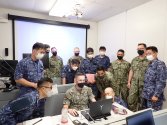More likely, it mirrors the Japanese. With the 055s taking the same role as Maya class DDGs while 052Ds take the role of Asahi class.
Both fleets are primarily defensive navies with some focus on anti submarine needs. Lengthened 052s can carry more helicopters for asw than normal frigates of that size. They also have very powerful radars that can help plug the gap of the 055s which are main line area defense destroyers.
Obviously the PLAN is overall larger, more capable, has proper naval aviation capability, and far more LHDs even. But the core idea of having a large and small DDG is quite reminiscent of the IJN.
I think it's more about the PLAN requirements
We can see China has settled on a 4-tier Surface Navy below
Type-056 Corvette (1600 tons) - 72 ships
Type-054 Frigate (4000 tons) - 50+ ships
Type-052 Destroyer (7500 tons) - 45+ ships
Type-055 Large Destroyer (13000 tons) - 16+ships
So you have 4 levels of warship platform from smallest to largest, which is also reflected in the cost of each ship. At the same time, the production numbers means that bugs can be identified in the initial ships, with the following ships being a mature design that can be mass-produced at low-cost.
Then it's a case of looking at the requirements matrix and deciding what is the most appropriate platform to use and how many of them to produce.
The 054 concept is kinda similar to the US LCS concept except China did it first and as such had the time to adjust and get better results with the program. Dubious small ships that work best in ASW and for patrolling during peacetime...
The LCS concept was an aberration, and was kindof supposed to replace the OH Perry Frigates.
And the Type-054 shares many similarities to the OH Perry Frigates because they have a similar mission.

